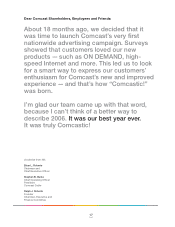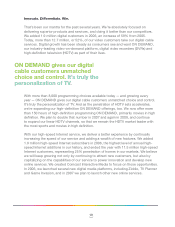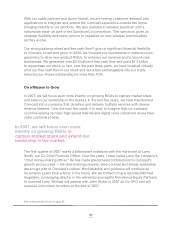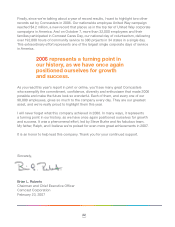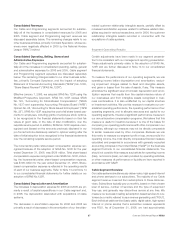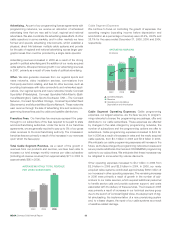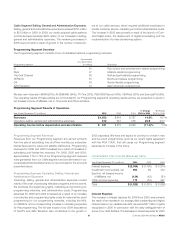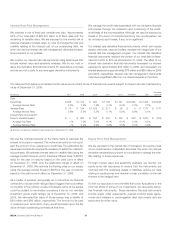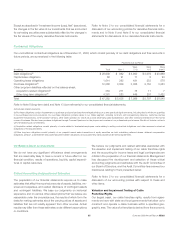Comcast 2006 Annual Report Download - page 29
Download and view the complete annual report
Please find page 29 of the 2006 Comcast annual report below. You can navigate through the pages in the report by either clicking on the pages listed below, or by using the keyword search tool below to find specific information within the annual report.
27 Comcast 2006 Annual Report MD&A
Consolidated Revenues
Our Cable and Programming segments accounted for substan-
tially all of the increases in consolidated revenues for 2006 and
2005. Cable segment and Programming segment revenues are
discussed separately below. The remaining changes relate to our
other business activities, primarily Comcast Spectacor, whose rev-
enues were negatively affected in 2005 by the National Hockey
League (“NHL”) lockout.
Consolidated Operating, Selling, General and
Administrative Expenses
Our Cable and Programming segments accounted for substan-
tially all of the increases in consolidated operating, selling, general
and administrative expenses for 2006 and 2005. Cable segment
and Programming segment expenses are discussed separately
below. The remaining changes relate to our other business activi-
ties, primarily Comcast Spectacor, and the impact of adopting
Statement of Financial Accounting Standards (“SFAS”) No. 123R,
“Share-Based Payment” (“SFAS No. 123R”).
Effective January 1, 2006, we adopted SFAS No. 123R using the
Modified Prospective Approach. SFAS No. 123R revises SFAS
No. 123, “Accounting for Stock-Based Compensation” (“SFAS
No. 123”) and supersedes Accounting Principles Board (“APB”)
Opinion No. 25, “Accounting for Stock Issued to Employees” (“APB
No. 25”). SFAS No. 123R requires the cost of all share-based pay-
ments to employees, including grants of employee stock options,
to be recognized in the financial statements based on their fair
values at grant date, or the date of later modification, over the
requisite service period. In addition, SFAS No. 123R requires unrec-
ognized cost (based on the amounts previously disclosed in our
pro forma footnote disclosure) related to options vesting after the
date of initial adoption to be recognized in the financial statements
over the remaining requisite service period.
The incremental pretax share-based compensation expense rec-
ognized because of the adoption of SFAS No. 123R for the year
ended December 31, 2006, was $126 million. Total share-based
compensation expense recognized under SFAS No. 123R, includ-
ing the incremental pretax share-based compensation expense,
was $190 million for the year ended December 31, 2006. Share-
based compensation expense is reflected in the operating results
of each of our business segments. Refer to Note 10 and Note 14
to our consolidated financial statements for further details on our
adoption of SFAS No. 123R.
Consolidated Depreciation and Amortization
The increases in depreciation expense for 2006 and 2005 are pri-
marily a result of capital expenditures in our Cable segment and,
in 2006, the depreciation associated with acquisitions of cable
systems.
The decreases in amortization expense for 2006 and 2005 are
primarily a result of decreases in the amortization of our franchise-
related customer relationship intangible assets, partially offset by
increased amortization expense related to software-related intan-
gibles acquired in various transactions, and in 2006, the customer
relationship intangible assets recorded in connection with the
acquisitions of cable systems.
Segment Operating Results
Certain adjustments have been made in our segment presenta-
tion to be consistent with our management reporting presentation.
These adjustments primarily relate to the adoption of SFAS No.
123R and are further discussed in Note 14 to our consolidated
financial statements.
To measure the performance of our operating segments, we use
operating income before depreciation and amortization, exclud-
ing impairment charges related to fixed and intangible assets,
and gains or losses from the sale of assets, if any. This measure
eliminates the significant level of noncash depreciation and amor-
tization expense that results from the capital-intensive nature of
our businesses and from intangible assets recognized in busi-
ness combinations. It is also unaffected by our capital structure
or investment activities. We use this measure to evaluate our con-
solidated operating performance, the operating performance of our
operating segments, and to allocate resources and capital to our
operating segments. It is also a significant performance measure in
our annual incentive compensation programs. We believe that this
measure is useful to investors because it is one of the bases for
comparing our operating performance with other companies in our
industries, although our measure may not be directly comparable
to similar measures used by other companies. Because we use
this metric to measure our segment profit or loss, we reconcile it to
operating income, the most directly comparable financial measure
calculated and presented in accordance with generally accepted
accounting principles in the United States (“GAAP”) in the business
segment footnote to our consolidated financial statements. You
should not consider this measure a substitute for operating income
(loss), net income (loss), net cash provided by operating activities,
or other measures of performance or liquidity we have reported in
accordance with GAAP.
Cable Segment Overview
Our cable systems simultaneously deliver video, high-speed Internet
and phone services to our subscribers. The majority of our Cable
segment revenue is earned from subscriptions to these cable ser-
vices. Subscribers typically pay us monthly, based on their chosen
level of service, number of services and the type of equipment
they use, and generally may discontinue service at any time. We
measure our success in selling subscription-based services to cus-
tomers by a metric referred to as a revenue generating unit (“RGU”).
Each individual cable service (basic cable, digital cable, high-speed
Internet or phone service) that a subscriber receives represents
one RGU. As of December 31, 2006, we had approximately


